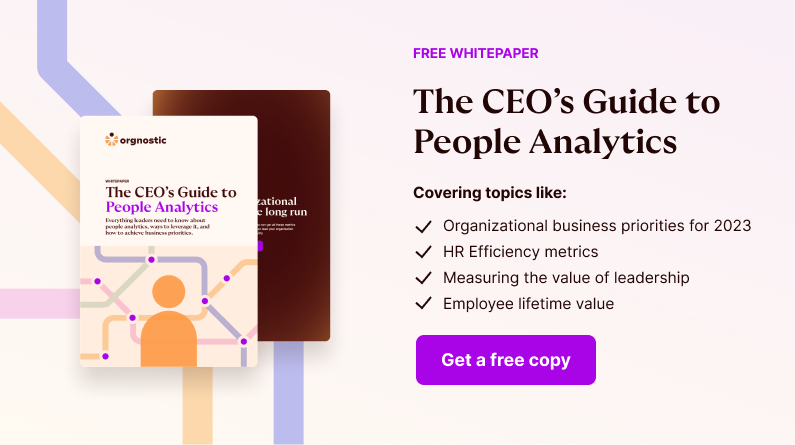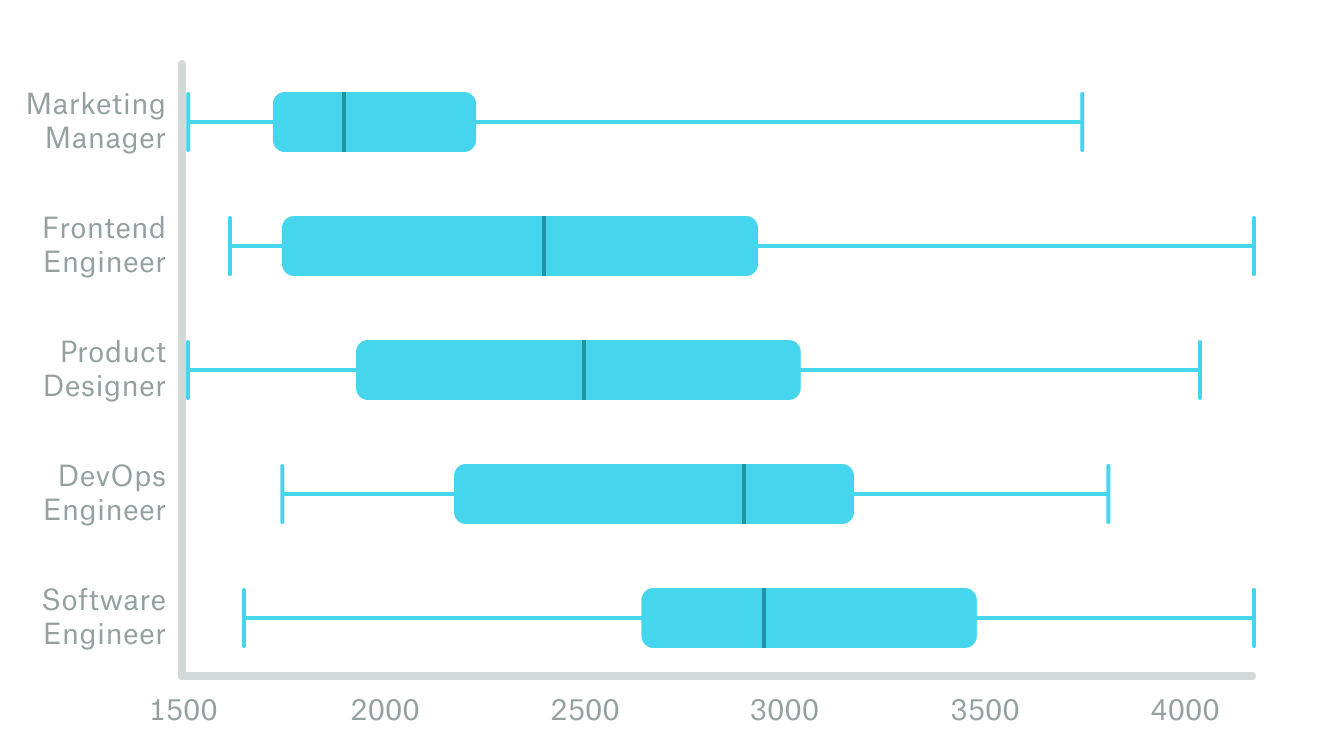Using data to improve talent acquisition, retention and diversity is becoming a must. Here’s how to build the people analytics function in your company.
Building a People Analytics function is becoming a top priority for executives and HR leaders — it informs business decisions and builds the credibility of HR as a strategic partner.
Data helps CHROs make decisions based on what works, assessing the true impact of their decisions and actions, and turning HR into an evidence-based, credible function that has the full trust of other executives.
To get started with making HR a truly strategic function, you have to navigate a crowded space of skills, software, and different approaches to HR data analytics. So, in this post, we lay down the blueprint that shows you how to build a people analytics function from the ground up.
At what company size should you start building the People Analytics function?
People Analytics is not reserved only for big companies (1000+ employees) — in fact, you can, and should, start using people data as early as you can.
There are several advantages to starting early on:
- it’s easy to track people data when your workforce is smaller
- it encourages discipline regarding using HR tools and keeping data clean
- it prevents data debt
- it’s less expensive and time-consuming to build the people analytics function as a small company.
People Analytics 101 — setting yourself up for success
Before diving into analytics and producing business-relevant insights, there are 4 fundamentals to master:
- data health
- handling employee data with care
- setting up your people analytics tech stack
- developing a data-driven mindset.

Make sure that your data is clean
The promise of using People Analytics to make the right decisions about your people is captivating. Every HR leader would love to be able to answer big questions with powerful software and present insightful visuals to company executives in no time.
However, to be able to achieve this promise, you first need to focus on less exciting, but crucial activities such as accurate data input, data cleaning, and database management.
Without good data going in, sophisticated analytics are not only inaccurate but also hard to manage.
But, what to do when you’re facing a large volume of data? You should start by cleaning the portion of data you need for a specific analysis, and move piece by piece.
People analytics platforms such as Orgnostic that allow you to prioritize cleaning the data you need right now can help with this task.
Treat employees as customers
People have become more conscious of their data and how it’s being collected and used — employees are no exception.
Following the legal requirements of collecting, storing, and using employees’ data is a given.
But beyond what’s legal, you should also ask yourself what makes sense from an employee’s perspective — is a certain data point too intrusive or irrelevant?
If collecting the data is likely to cause a stir, consider the benefits and whether the risks are worth it.
Remember: just because you can measure it, it doesn’t mean you should.
This especially holds true when getting started with People Analytics — it’s vital to start by gaining people’s trust and helping them see the value in using people analytics tools.
Set up your people analytics tech stack
People Analytics is strongly intertwined with technology. To set up a foundation for data analysis, the basic tools you need are an HRIS and an ATS for collecting data on candidates and employees, and a people analytics platform to help you analyze the data.
As you get involved with People Analytics, you will discover tools and solutions for different steps of the employee journey, from managing data, and launching wellbeing surveys, to running turnover analysis, to visualizing the results.
Try to keep your HR tech stack lean in the beginning. If you go beyond having an HRIS, an ATS, and a people analytics platform when you’re just getting started, not only will you end up with expensive software you don’t use, but you will also need to be involved in extensive training that some of these tools require.
Instead, spend your budget wisely and invest in people analytics tech that lets you get tangible results within weeks of being implemented. The more tangible the results you achieve at a small scale, the easier it will be to demonstrate value and secure the budget — and the buy-in from your team — to grow your HR analytics function.
Nurture the analytics skillset
The core of an efficient people analytics function is not the tools, but the skills to make insights out of the data.
This doesn’t necessarily mean hiring a People Analyst or setting up a full-blown people data team straight off the bat. These experts are often hard to find and expensive to hire, especially for smaller organizations.
What you can do is focus first on nurturing the analytics mindset within your HR and people operations teams. Good data analytics is about sense-making, not getting swarmed with tools.
First 90 days in People Analytics
With basics covered, it’s time for the first steps — a sensible time when you can boost success through a few practical tips:
Run pilots to get quick wins
Similarly to the temptation of buying advanced software, once you get started, you might want to go big on the analysis your team runs. But it’s better to go small in the beginning, to confirm the investment is worth it, and to showcase what the new People Analytics function can achieve.
Piloting is a great approach at this point: it allows you to calibrate your team, tools, and approach, while delivering quickly some tangible results to get leaders’ appetite.
Choose one business or people question you want to answer for a department or a specific part of the organization and produce your first insights by analyzing in-depth the data related to it, before attempting to put everything in place for the whole organization.
Turn data into insights — then act on them
Analytics gets people excited, but its true value comes from using it to take action.
When starting with the People Analytics function, show the true value of your work by translating your findings into actionable insights for the strategic and senior leadership.
For example, a relatively simple analysis you can start with is checking if all of your employees in the same roles get equal compensation.

Make sure to use storytelling backed with data to present your findings and pitch a solution to your business stakeholders.
To get the green light for your suggested initiatives you will need a different skill set than the analytical abilities needed for the rest of the work. Deliver actionable insights early on, and you’ll have the leaders’ attention in no time.
Here are some other analyses you can do throughout different areas of your employee lifecycle:
Talent Acquisition
Applying people analytics to Talent Acquisition uncovers numerous insights, including:
- Where do people in your talent pipeline come from, which sources pay off and which should you stop using?
- Are some stages in your hiring process too strict or not selective enough, and which hiring bottleneck do you face?
- How much time do people in your hiring pipeline spend waiting in each stage of the hiring process?
Diversity, Equity & Inclusion
Diversity, equity and inclusion analytics let you create more inclusive people practices, by answering questions like:
- Do employees in the same roles get equal compensation, regardless of their gender and ethnicity?
- What is your distribution of women across roles and job levels?
- What is the diversity breakdown of our top performers and high potential employees?
Talent Management
Through talent management analytics, you can answer the following questions:
- How long does it take a new employee to be fully productive
- How long does it take to find and onboard a replacement?
- Why do your employees leave?
Culture
When you run analytics on your organizational culture, you can find out:
Employee Wellbeing
Within Employee Wellbeing analytics, you can find out answers to questions like:
- What team dynamics and processes lead to lower engagement or higher burnout risk?
- What is the impact of employee wellbeing on referrals?
Turnover / Retention
Using turnover and retention metrics, you find out:
Do informed hypothesis-testing
One approach to analytics is playing with the data (or “mining” it) to find potentially interesting links, and looking for their practical meaning.
Another, more robust approach, is to ask questions first, work out hypotheses, and then use data to test them.
To find the right questions, work with business leaders to understand their pressing issues and, with your HR team, select those that can be informed by People Analytics. Along with business issues, scientific research can inform your hypothesis — look for what research has identified as the root causes of the issues you’ve identified. Then work with your data to test the relationships and pinpoint the driving factors in your organization.
Scaling up your People Analytics function
Once you’ve delivered the first insights and leaders see the value in People Analytics, it’s time to scale up. To make these efforts sustainable, there are two principles to follow:
- Collect data in moderation
- Democratize data access
Dose efforts to gather more data
Soon after you start with People Analytics, you’ll likely face interesting questions that can be answered through data… that you don’t have.
So, you want to gather it — an employee survey can help you get data about the company culture or people’s well-being.
At this moment, you have to fight off the temptation of launching countless surveys to your workforce: they will soon become fatigued. Response rates will go down, and excitement about your new People Analytics function will falter, as it will become known as “those guys asking us again to answer a bunch of questions…”.
To avoid this, prioritize the missing data and leave enough time between surveys to avoid fatigue, and keep them short.
Democratize access to data
Once employees and leaders alike understand the value of People Analytics, you can open up and give them more immediate, direct access to dynamic data insights.
Consider sharing a dashboard or custom report for leaders and HR colleagues, grouped by key topics of their interest. This way, people will feel part of your efforts and will understand the data better, accepting the insights based on it.
If you want to gain your leaders’ trust and become a strategic partner, now is the right time to get started with People Analytics in your organization — you can benefit from the increasing amount of data available, as well as from a myriad of resources, approaches, and tools at your fingertips.
